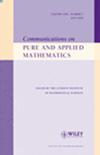随机稀疏Richardson迭代:一个维数无关的稀疏线性解算器
IF 2.7
1区 数学
Q1 MATHEMATICS
引用次数: 0
摘要
最近,一类将经典不动点迭代与近似解向量的重复随机稀疏化相结合的算法已经成功地应用于矩阵为。迄今为止,对这一成功的完整数学解释尚不明确。这类方法尚未推广到求解线性系统的重要情况。本文提出了一种基于重复随机稀疏化的求解任意高维稀疏线性系统的新方案。我们对这个新算法进行了完整的数学分析。我们的分析建立了一个比蒙特卡罗更快的收敛速度,并证明了即使解决方案太大而无法作为密集向量存储时也可以使用该方案。本文章由计算机程序翻译,如有差异,请以英文原文为准。
Randomly sparsified Richardson iteration: A dimension‐independent sparse linear solver
Recently, a class of algorithms combining classical fixed‐point iterations with repeated random sparsification of approximate solution vectors has been successfully applied to eigenproblems with matrices as large as . So far, a complete mathematical explanation for this success has proven elusive.The family of methods has not yet been extended to the important case of linear system solves. In this paper, we propose a new scheme based on repeated random sparsification that is capable of solving sparse linear systems in arbitrarily high dimensions. We provide a complete mathematical analysis of this new algorithm. Our analysis establishes a faster‐than‐Monte Carlo convergence rate and justifies use of the scheme even when the solution is too large to store as a dense vector.
求助全文
通过发布文献求助,成功后即可免费获取论文全文。
去求助
来源期刊
CiteScore
6.70
自引率
3.30%
发文量
59
审稿时长
>12 weeks
期刊介绍:
Communications on Pure and Applied Mathematics (ISSN 0010-3640) is published monthly, one volume per year, by John Wiley & Sons, Inc. © 2019.
The journal primarily publishes papers originating at or solicited by the Courant Institute of Mathematical Sciences. It features recent developments in applied mathematics, mathematical physics, and mathematical analysis. The topics include partial differential equations, computer science, and applied mathematics. CPAM is devoted to mathematical contributions to the sciences; both theoretical and applied papers, of original or expository type, are included.

 求助内容:
求助内容: 应助结果提醒方式:
应助结果提醒方式:


